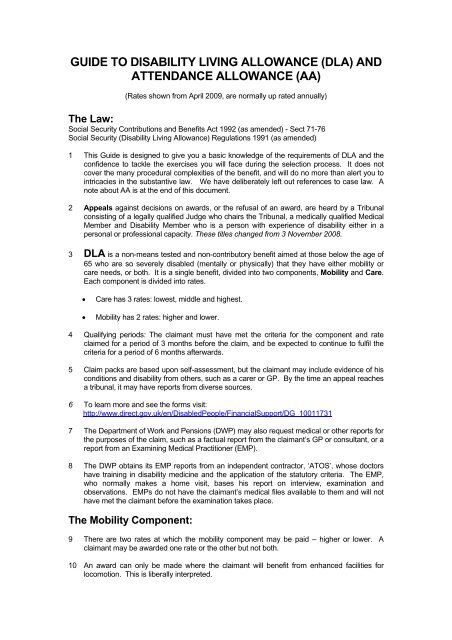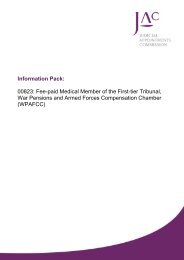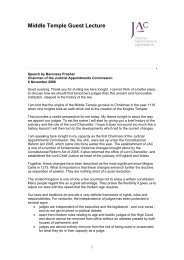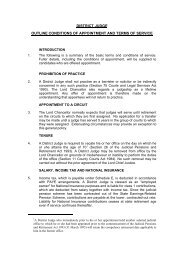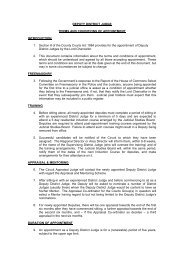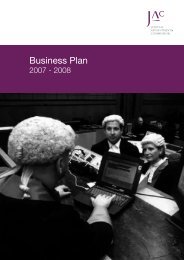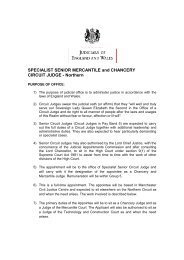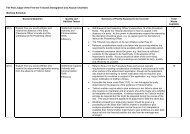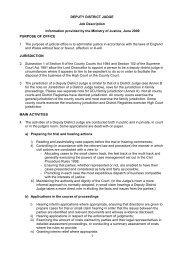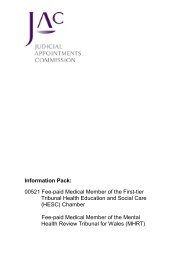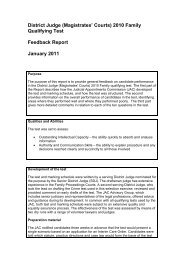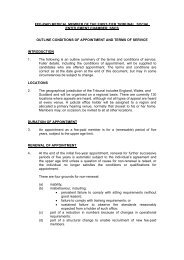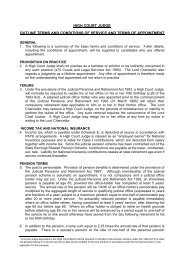guide to disability living allowance (dla) and attendance allowance
guide to disability living allowance (dla) and attendance allowance
guide to disability living allowance (dla) and attendance allowance
- No tags were found...
Create successful ePaper yourself
Turn your PDF publications into a flip-book with our unique Google optimized e-Paper software.
GUIDE TO DISABILITY LIVING ALLOWANCE (DLA) ANDATTENDANCE ALLOWANCE (AA)(Rates shown from April 2009, are normally up rated annually)The Law:Social Security Contributions <strong>and</strong> Benefits Act 1992 (as amended) - Sect 71-76Social Security (Disability Living Allowance) Regulations 1991 (as amended)1 This Guide is designed <strong>to</strong> give you a basic knowledge of the requirements of DLA <strong>and</strong> theconfidence <strong>to</strong> tackle the exercises you will face during the selection process. It does notcover the many procedural complexities of the benefit, <strong>and</strong> will do no more than alert you <strong>to</strong>intricacies in the substantive law. We have deliberately left out references <strong>to</strong> case law. Anote about AA is at the end of this document.2 Appeals against decisions on awards, or the refusal of an award, are heard by a Tribunalconsisting of a legally qualified Judge who chairs the Tribunal, a medically qualified MedicalMember <strong>and</strong> Disability Member who is a person with experience of <strong>disability</strong> either in apersonal or professional capacity. These titles changed from 3 November 2008.3 DLA is a non-means tested <strong>and</strong> non-contribu<strong>to</strong>ry benefit aimed at those below the age of65 who are so severely disabled (mentally or physically) that they have either mobility orcare needs, or both. It is a single benefit, divided in<strong>to</strong> two components, Mobility <strong>and</strong> Care.Each component is divided in<strong>to</strong> rates.Care has 3 rates: lowest, middle <strong>and</strong> highest.Mobility has 2 rates: higher <strong>and</strong> lower.4 Qualifying periods: The claimant must have met the criteria for the component <strong>and</strong> rateclaimed for a period of 3 months before the claim, <strong>and</strong> be expected <strong>to</strong> continue <strong>to</strong> fulfil thecriteria for a period of 6 months afterwards.5 Claim packs are based upon self-assessment, but the claimant may include evidence of hisconditions <strong>and</strong> <strong>disability</strong> from others, such as a carer or GP. By the time an appeal reachesa tribunal, it may have reports from diverse sources.6 To learn more <strong>and</strong> see the forms visit:http://www.direct.gov.uk/en/DisabledPeople/FinancialSupport/DG_100117317 The Department of Work <strong>and</strong> Pensions (DWP) may also request medical or other reports forthe purposes of the claim, such as a factual report from the claimant’s GP or consultant, or areport from an Examining Medical Practitioner (EMP).8 The DWP obtains its EMP reports from an independent contrac<strong>to</strong>r, ‘ATOS’, whose doc<strong>to</strong>rshave training in <strong>disability</strong> medicine <strong>and</strong> the application of the statu<strong>to</strong>ry criteria. The EMP,who normally makes a home visit, bases his report on interview, examination <strong>and</strong>observations. EMPs do not have the claimant’s medical files available <strong>to</strong> them <strong>and</strong> will nothave met the claimant before the examination takes place.The Mobility Component:9 There are two rates at which the mobility component may be paid – higher or lower. Aclaimant may be awarded one rate or the other but not both.10 An award can only be made where the claimant will benefit from enhanced facilities forlocomotion. This is liberally interpreted.
cannot prepare a cooked main meal for himself if he has the ingredients (if 16 years ofage or over).23 Middle Rate (£47.10 per week): Entitlement can be based on fulfilment of either day ornight conditions.24 Day conditions for the middle rate are satisfied if the claimant has ‘attention’ or‘supervision’ needs of the appropriate extent.25 Daytime ‘attention’ needs are established when the claimant requires frequent attentionthroughout the day from another person in connection with bodily functions throughout theday.26 Daytime ‘supervision’ needs are established when the claimant requires continualsupervision throughout the day from another person <strong>to</strong> avoid substantial danger <strong>to</strong> himselfor others.27 A claimant cannot qualify for the middle rate of care by combining some daytime attentionneeds with some daytime supervision needs.28 Night conditions for the middle rate are satisfied if the claimant shows either that:or, at night, he requires from another person prolonged or repeated attention inconnection with bodily functions;at night, requires another person <strong>to</strong> be awake for a prolonged period, or at frequentintervals, <strong>to</strong> watch over him <strong>to</strong> avoid substantial danger <strong>to</strong> himself or others.29 Highest Rate (£70.35 per week): This rate is payable <strong>to</strong> a claimant who has needs duringthe day <strong>and</strong> night such that he satisfies one of the daytime middle rate conditions <strong>and</strong> onenight time condition.30 The permutations:day attention + night attentionday attention + night watching overday supervision + night attentionday supervision + night watching over31 Satisfaction of the lowest rate of care plus night needs does not lead <strong>to</strong> any extra benefit.The claimant will only be entitled <strong>to</strong> the higher of the two rates, viz. the middle rate based onnight needs only.The terminology32 A disabled person’s condition may vary over time, with good days <strong>and</strong> bad days. It istherefore a matter of judgment whether the claimant satisfies the conditions throughout theperiod. There is no arithmetical formula, <strong>and</strong> a broad view must be taken.33 Requires: ‘Requires’ means ‘reasonably requires’. A claimant may be getting a great dealof attention from family, friends or carers, but looked at objectively, may not reasonably needit because simple aids <strong>and</strong> devices may be available <strong>to</strong> enable him <strong>to</strong> manageindependently. Alternatively, a claimant may not be getting any assistance at all (perhapsbecause he lives alone), but looked at objectively, may reasonably require it. However, aperson who is managing at home on his own may have developed coping strategies,adapted <strong>to</strong> his disabilities or acquired aids <strong>and</strong> equipment such that he does not reasonablyrequire help.
no supervision will be required. Where a person suffers falls in unpredictable situations, thequestion of whether supervision is required is acute.46 Night needs: prolonged or repeated attention: The test is broad brush, <strong>and</strong> there is noinflexible benchmark in determining whether the criteria are met – all the circumstancesmust be considered.47 Watching over – This test requires another person <strong>to</strong> be awake for a prolonged period or atfrequent intervals for the purpose of watching over the claimant.Attendance Allowance (AA)48 As described above DLA is paid <strong>to</strong> claimants aged under 65. It comprises two levels ofMobility Component, <strong>and</strong> three levels of Care Component.49 AA is paid <strong>to</strong> claimants aged over 65. It has two levels, both based upon reasonablyrequired care or supervision needs. The criteria are identical <strong>to</strong> those for the middle <strong>and</strong>highest levels of DLA.50 Note - There are two significant differences between DLA <strong>and</strong> AA:There is no mobility component nor an equivalent <strong>to</strong> Lowest Rate Care Component, butawards of these components in DLA made before the 65 th birthday continue in payment ifthe eligibility criteria remain satisfied.The claimant must have met the criteria for 6 (instead of 3) months before the claim.


